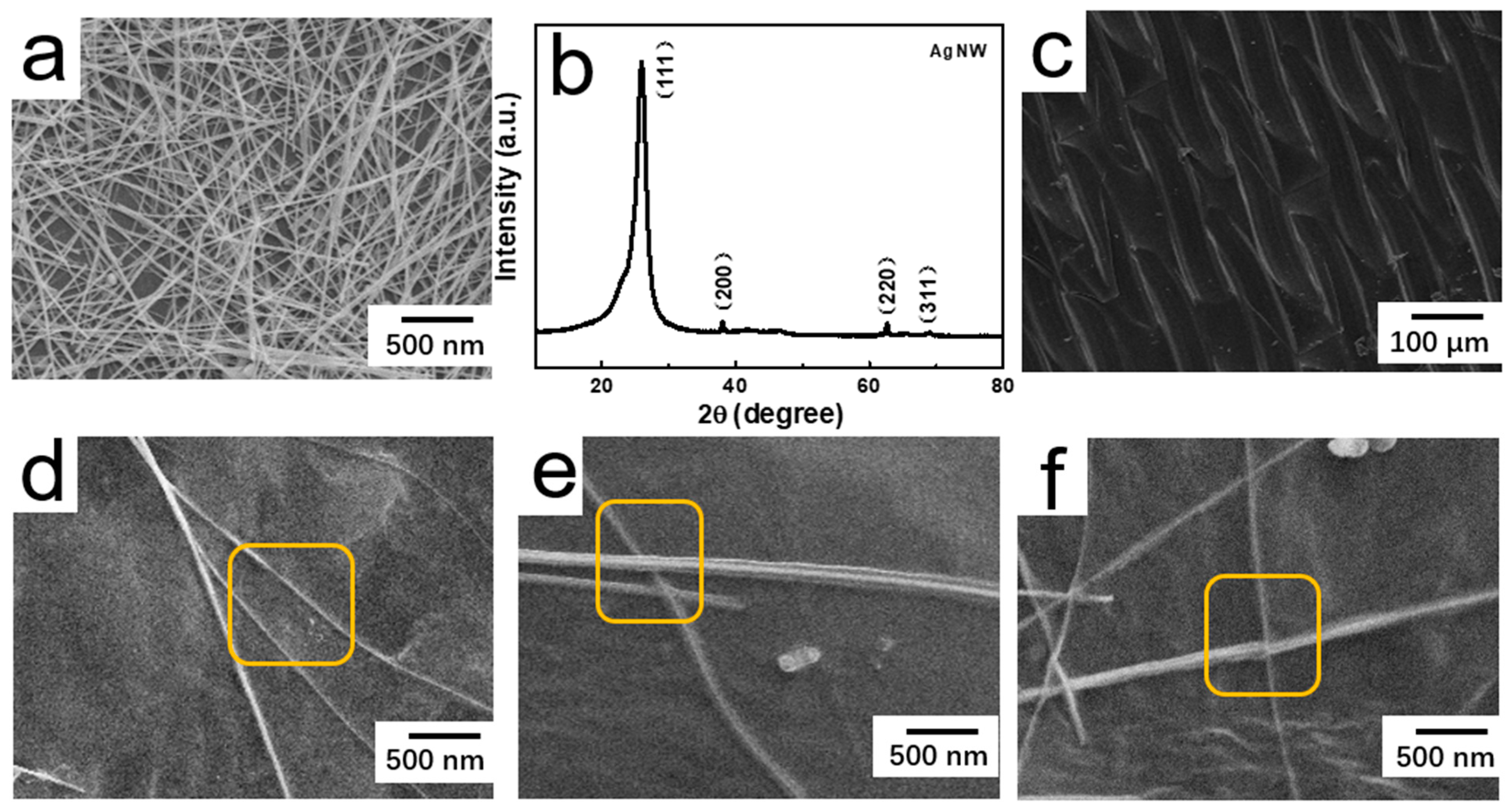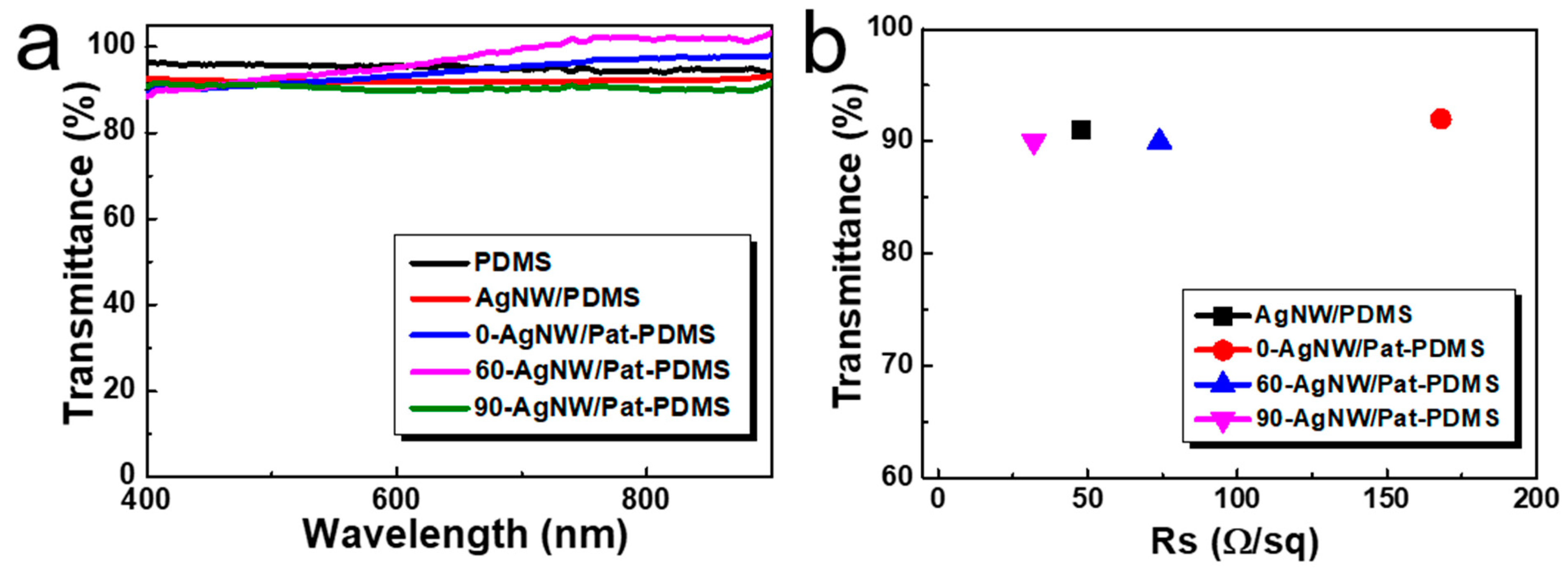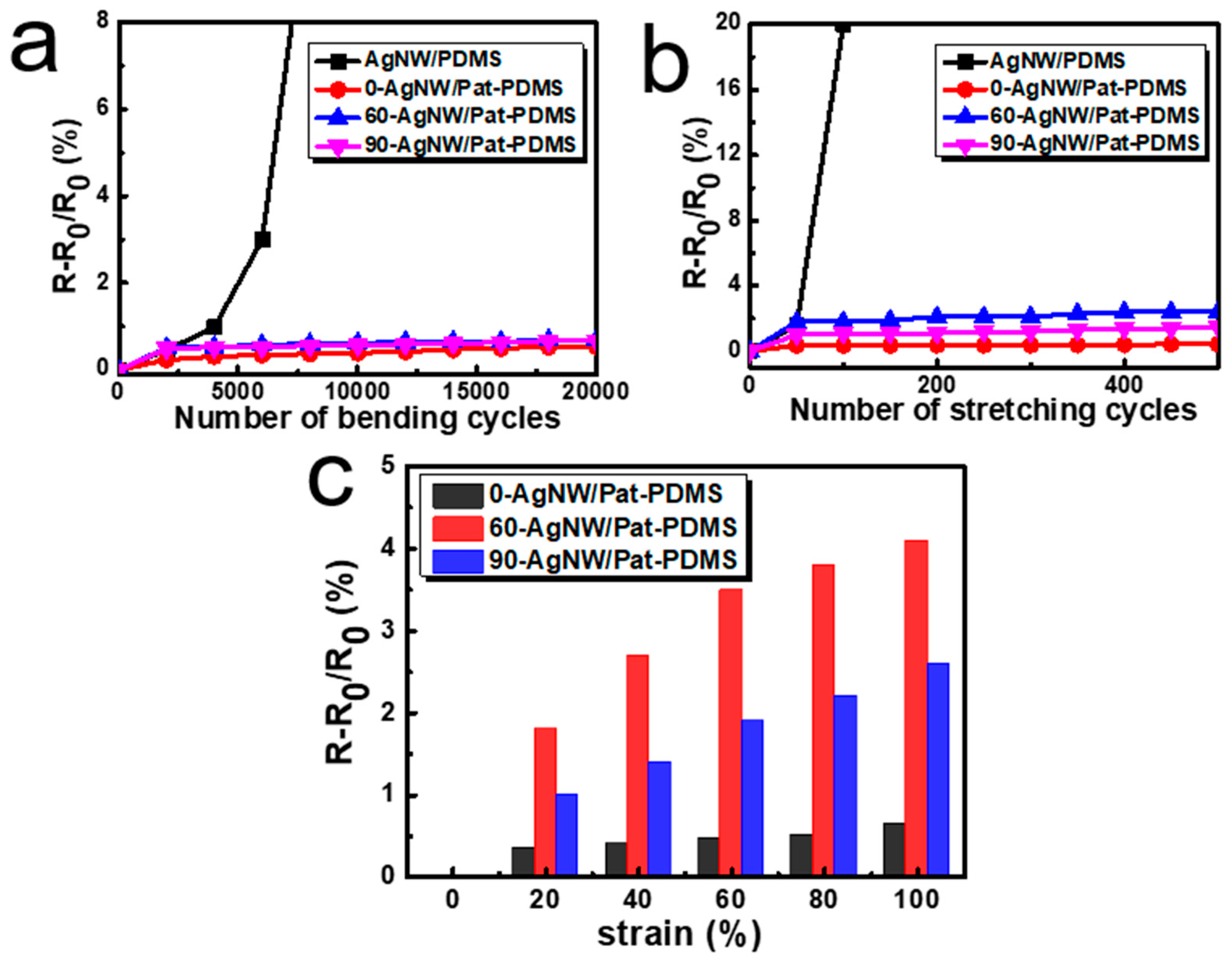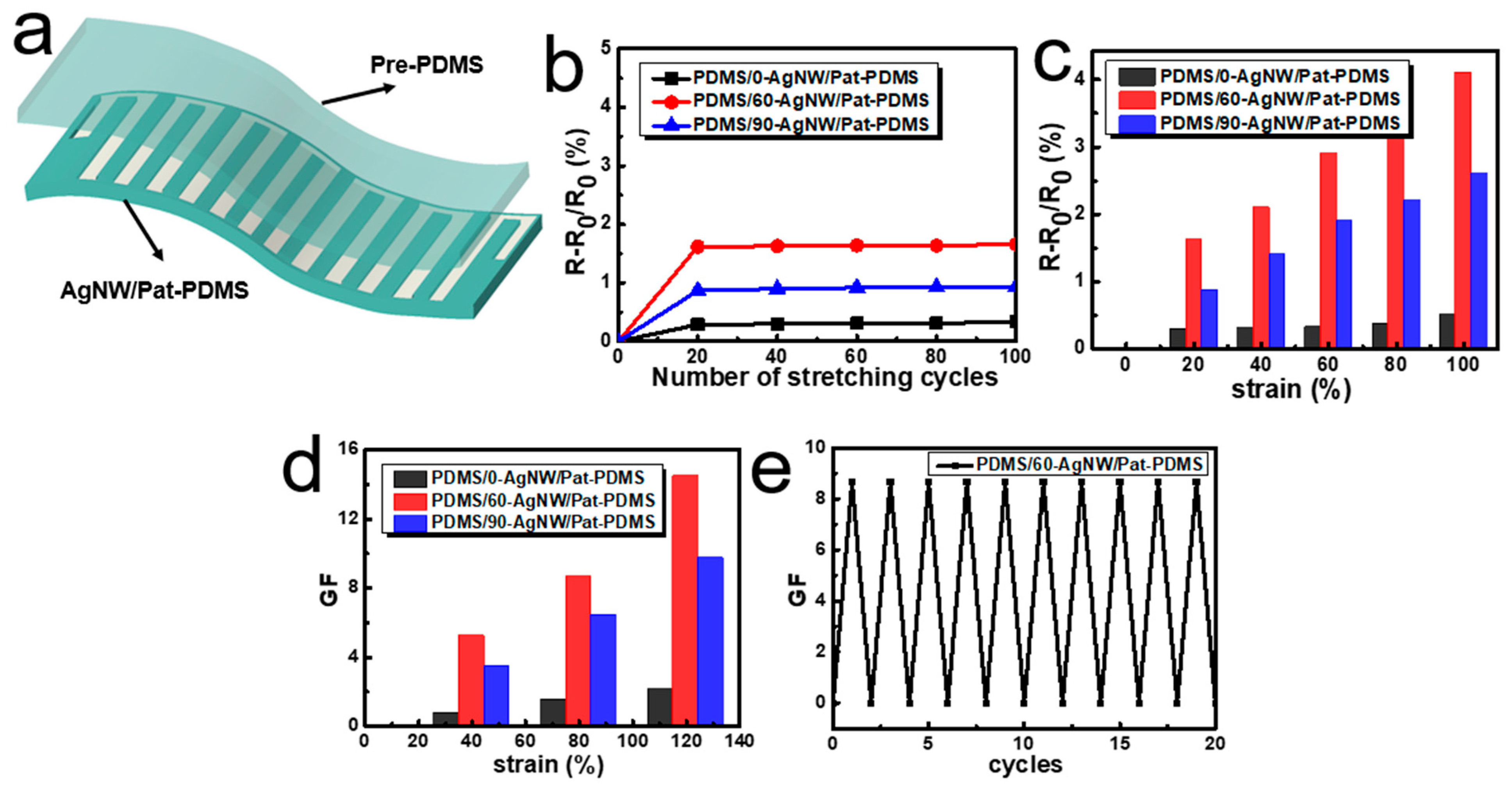Flexible Transparent Films of Oriented Silver Nanowires for a Stretchable Strain Sensor
Abstract
:1. Introduction
2. Experimental Section
2.1. Reagents and Materials
2.2. Synthesis of AgNWs
2.3. Preparation of Patterned PDMS Film
2.4. Preparation of AgNW/Pat-PDMS Films
2.5. Preparation of the PDMS/AgNW/Pat-PDMS Pressure Sensor
2.6. Characterization
3. Results and Discussion
3.1. Structure and Morphology
3.2. The Optoelectrical Properties of Electrodes
3.3. Sensor Application Performance
4. Conclusions
Supplementary Materials
Author Contributions
Funding
Institutional Review Board Statement
Informed Consent Statement
Data Availability Statement
Conflicts of Interest
References
- He, J.; Zhou, R.; Zhang, Y.; Gao, W.C. Strain-Insensitive Self-Powered Tactile Sensor Arrays Based on Intrinsically Stretchable and Patternable Ultrathin Conformal Wrinkled Graphene-Elastomer Composite. Adv. Funct. Mater. 2021, 13, 2107281. [Google Scholar] [CrossRef]
- Liang, F.C.; Chang, Y.W.; Kuo, C.C.; Cho, C.J.; Jiang, D.H.; Jhuang, F.C.; Rwei, S.P.; Borsali, R. A Mechanically Robust Silver Nanowire–polydimethylsiloxane Electrode based on Facile Transfer Printing Techniques for Wearable Displays. Nanoscale 2019, 11, 1520–1530. [Google Scholar] [CrossRef]
- Deng, B.; Hsu, P.C.; Chen, G.; Chandrashekar, B.N.; Liao, L.; Ayitimuda, Z.; Wu, J.; Guo, Y.; Lin, L.; Zhou, Y. Roll-to-Roll Encapsulation of Metal Nanowires between Graphene and Plastic Substrate for High-Performance Flexible Transparent Electrodes. Nano Lett. 2015, 15, 4206–4213. [Google Scholar] [CrossRef]
- Alesanco, Y.; Vinuales, A.I.; Palenzuela, J.; Odriozola, I.; Cabañero, G.; Rodriguez, J.; Tena-Zaera, R. Multicolor Electrochromics: Rainbow-like Devices. Acs Appl. Mater. Interfaces 2016, 8, 14795–14801. [Google Scholar] [CrossRef]
- Ran, J.; Xu, R.; Xia, R.; Cheng, D.; Yao, J.; Bi, S.; Cai, G.; Wang, X. Carbon Nanotube/polyurethane Core-Sheath Nanocomposite Fibers for Wearable Strain Sensors and Electro-thermochromic Textiles. Smart Mater. Struct. 2021, 30, 075022. [Google Scholar] [CrossRef]
- Kim, H.K. Highly flexible and transparent CuO/Cu/CuO mesh electrodes grown by roll to roll sputtering for flexible touch screen panels. Sci. Rep. 2016, 8, 139. [Google Scholar]
- Kim, Y.; Ryu, T.I.; Ok, K.H.; Kwak, M.G.; Park, S.; Park, N.G.; Han, C.J.; Kim, B.S.; Min, J.K.; Son, H.J. Inverted Layer-By-Layer Fabrication of an Ultraflexible and Transparent Ag Nanowire/Conductive Polymer Composite Electrode for Use in High-Performance Organic Solar Cells. Adv. Funct. Mater. 2015, 25, 4580–4589. [Google Scholar] [CrossRef]
- Lu, X.; Zhang, Y.; Zheng, Z. Metal-Based Flexible Transparent Electrodes: Challenges and Recent Advances. Adv. Electron. Mater. 2021, 7, 2001121. [Google Scholar] [CrossRef]
- Chen, W.; Liu, L.X.; Zhang, H.B.; Yu, Z.Z. Flexible, Transparent and Conductive Ti3C2Tx MXene-Silver Nanowire Films with Smart Acoustic Sensitivity for High-Performance Electromagnetic Interference Shielding. ACS Nano 2020, 14, 16643–16653. [Google Scholar] [CrossRef]
- Cai, W.; Zhu, Y.; Li, X.; Piner, R.D.; Ruoff, R.S. Large Area Few-layer Graphene/graphite Films as Transparent Thin Conducting Electrodes. Appl. Phys. Lett. 2009, 95, 123115. [Google Scholar] [CrossRef]
- Peng, K.; Liu, L.Q.; Gao, Y.; Qu, M.Z.; Zhang, Z. Fabrication of High Optical Transparent and Conductive SWNT Based Transparent Conducting Film on Flexible Plastic Substrate Using Ozone as a Redox Dopant. J. Nanosci. Nanotechnol. 2010, 10, 7386. [Google Scholar] [CrossRef] [PubMed]
- Lin, Y.; Yuan, W.; Ding, C.; Chen, S.; Li, F. Facile and Efficient Patterning Method for Silver Nanowires and Its Application to Stretchable Electroluminescent Displays. ACS Appl. Mater. Interfaces 2020, 12, 24074–24085. [Google Scholar] [CrossRef] [PubMed]
- Wang, C.; Wen, Z.; Yue, Z.; Too, C.O.; Wallace, C.G. Buckled, Stretchable Polypyrrole Electrodes for Battery Applications. Adv. Mater. 2011, 23, 3580–3584. [Google Scholar] [CrossRef] [PubMed]
- Lee, C.; Yu, Z. Prepolymerization-assisted Fabrication of an Ultrathin Immobilized Layer to Realize a Semi-embedded Wrinkled AgNW Network for a Smart Electrothermal Chromatic Display and Actuator. J. Mater. Chem. C 2017, 5, 9778–9785. [Google Scholar]
- Jla, D.; Qsa, D.; Ys, C.; Ch, A.; Yl, B.; Qz, B.; Hw, A. Cladding Nanostructured AgNWs-MoS2 Electrode Material for High-rate and Long-life Transparent in-plane Micro-supercapacitor. Energy Storage Mater. 2019, 16, 212–219. [Google Scholar]
- Li, X.; Yu, S.; Zhao, L.; Wu, M.; Dong, H. Hybrid PEDOT:PSS to obtain high-performance AgNW-based flexible transparent electrodes for transparent heaters. J. Mater. Sci. Mater. Electron. 2020, 31, 5395–5540. [Google Scholar]
- Zhou, B.; Su, M.; Yang, D.; Han, G.; Feng, Y.; Wang, B.; Ma, J.; Ma, J.; Liu, C.; Shen, C. Flexible MXene/Silver Nanowire-Based Transparent Conductive Film with Electromagnetic Interference Shielding and Electro-Photo-Thermal Performance. ACS Appl. Mater. Interfaces 2020, 12, 40859–40869. [Google Scholar] [CrossRef] [PubMed]
- Kim, X.Y.; Zhang, Q.K.; Yu, R.M.; Lu, C.Z. A New Transparent Conductor: Silver Nanowire Film Buried at the Surface of a Transparent Polymer. Adv. Mater. 2010, 22, 4484–4488. [Google Scholar]
- Lee, Y.; Min, G.; Dahiya, A.S.; Ejaz, A.; Shakthivel, D.; Dahiya, R. Kirigami and Mogul-Patterned Ultra-Stretchable High-Performance ZnO Nanowires-Based Photodetector. Adv. Mater. Technol. 2021, 7, 2100804. [Google Scholar]
- Dai, H.S.; Pan, B.C.; Liou, G.S. Highly Transparent AgNW/PDMS Stretchable Electrodes for Elastomeric Electrochromic Devices. Nanoscale 2017, 9, 2633–2639. [Google Scholar]
- Lin, Y.; Li, Q.; Ding, C.; Wang, J.; Cui, Z. High-resolution and Large-size Stretchable Electrodes Based on Patterned Silver Nanowires Composites. Nano Res. 2022, 15, 4590–4598. [Google Scholar] [CrossRef]
- Lin, Y.; Wang, H. TiO2 Coated Core–Shell Ag Nanowire Networks for Robust and Washable Flexible Transparent Electrodes. ACS Appl. Nano Mater. 2019, 2, 2456–2466. [Google Scholar]
- Hao, T.; Wang, S.; Xu, H.; Zhang, X.; Magdassi, S.; Pan, L.; Song, Y.; Li, Y.; Zhao, J. Novel Transparent TiO2/AgNW–Si (NH2)/PET Hybrid Films for Flexible Smart Windows. ACS Appl. Mater. Interfaces 2022, 14, 21613–21622. [Google Scholar] [CrossRef]
- Cheng, L.; Lin, T.; Yan, W.; Chen, E. Preparation and Characterization of Electrochromic Tungsten Oxide–titania Composite Thin Films with Different Tungsten/titanium Ratios. Thin Solid Film. 2014, 556, 48–53. [Google Scholar]
- Shen, L.; Du, L.; Tan, S.; Zang, Z.; Zhao, C.; Mai, W. Flexible Electrochromic Supercapacitor Hybrid Electrodes Based on Tungsten Oxide Films and Silver Nanowires. Chem. Commun. 2016, 52, 6296–6299. [Google Scholar] [CrossRef]
- Zhou, Y.; Zhan, P.; Ren, M.; Zheng, G.; Dai, K.; Chuntai, L.; Shen, C. Significant Stretchability Enhancement of Crack-based Strain Sensor combined with High Sensitivity and Superior Durability for Motion Monitoring. ACS Appl. Mater. Interfaces 2019, 11, 7405–7414. [Google Scholar] [CrossRef]
- Lee, S.; Kim, C. Highly flexible, stretchable, durable conductive electrode for human-body-attachable wearable sensor application. Polym. Test. 2023, 122, 108018. [Google Scholar] [CrossRef]
- Wang, H.; Zhou, R.; Li, D.; Zhang, L.; Ren, G.; Wang, L.; Wang, D. High-Performance Foam-Shaped Strain Sensor Based on Carbon Nanotubes and Ti3C2Tx Mxene for the Monitoring of Human Activities. ACS Nano 2021, 15, 9690–9700. [Google Scholar] [CrossRef]
- Yoo, C.; Lee, S.; Song, Y. Micro/nano-wrinkled elastomeric electrodes enabling high energy storage performanceand various formfactors. Carbon Energy 2022, 5, e335. [Google Scholar] [CrossRef]
- Kim, K.; Lee, J.; Jo, E.; Sim, S. Patterned Carbon Nanotube Bundles as Stretchable Strain Sensors for Human Motion Detection. ACS Appl. Nano Mater. 2020, 42, 457–462. [Google Scholar] [CrossRef]
- Kim, J.; Park, J.; Jeong, U.; Park, U. Silver nanowire network embedded in polydimethylsiloxane as stretchable, transparent, and conductive substrates. J. Appl. Polym. Sci. 2016, 18, 627–635. [Google Scholar] [CrossRef]





| Samples | 20,000 Bending Cycles (%) | 500 Stretching Cycles (%) | 20~100% Tensile Strain (%) |
|---|---|---|---|
| AgNW/PDMS | 183 | - | - |
| 0-AgNW/Pat-PDMS | 0.53 | 0.65 | 0.49~0.71 |
| 60-AgNW/Pat-PDMS | 0.69 | 4.1 | 1.81~4.23 |
| 90-AgNW/Pat-PDMS | 0.58 | 2.6 | 0.98~2.45 |
Disclaimer/Publisher’s Note: The statements, opinions and data contained in all publications are solely those of the individual author(s) and contributor(s) and not of MDPI and/or the editor(s). MDPI and/or the editor(s) disclaim responsibility for any injury to people or property resulting from any ideas, methods, instructions or products referred to in the content. |
© 2024 by the authors. Licensee MDPI, Basel, Switzerland. This article is an open access article distributed under the terms and conditions of the Creative Commons Attribution (CC BY) license (https://creativecommons.org/licenses/by/4.0/).
Share and Cite
Wang, X.; Song, C.; Wang, Y.; Feng, S.; Xu, D.; Hao, T.; Xu, H. Flexible Transparent Films of Oriented Silver Nanowires for a Stretchable Strain Sensor. Materials 2024, 17, 4059. https://doi.org/10.3390/ma17164059
Wang X, Song C, Wang Y, Feng S, Xu D, Hao T, Xu H. Flexible Transparent Films of Oriented Silver Nanowires for a Stretchable Strain Sensor. Materials. 2024; 17(16):4059. https://doi.org/10.3390/ma17164059
Chicago/Turabian StyleWang, Xiaoguang, Chengjun Song, Yangyang Wang, Shaoxuan Feng, Dong Xu, Tingting Hao, and Hongbo Xu. 2024. "Flexible Transparent Films of Oriented Silver Nanowires for a Stretchable Strain Sensor" Materials 17, no. 16: 4059. https://doi.org/10.3390/ma17164059




